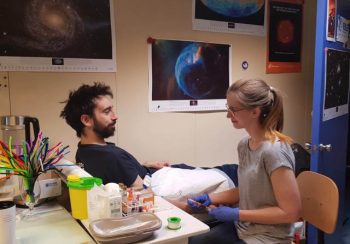Dr. Carmen Possnig is the ESA-sponsored medical doctor spending 12 months at Concordia research station in Antarctica. She facilitates a number of experiments on the effects of isolation, light deprivation, and extreme temperatures on the human body and mind. In the following post, Carmen discusses the European experiments she is performing in Antarctica.
“Next scenario: You are a pilot in the Soyuz, autopilot docking doesn’t work, you have to do it manually. At the same time you realize that the International Space Station has a problem: it is out of control and rotates around an axis. Good luck!”
I enter the scenario into the computer and wait until my respondent has completed the preflight checks and selected a target. Then I close the curtain and my colleague is now undisturbed – with his monitors he can fully concentrate on docking to the Space Station. Then I lean back and watch the flight progress.
For one of the ESA experiments my crew members fly a Soyuz capsule simulator every month. The Soyuz is the Russian spacecraft that currently brings astronauts to the International Space Station. If the radar navigation system fails on its way to the Space Station, the pilots have to dock manually. If the target monitor also fails, docking must be purely visual and with the help of a periscope. If the Space Station were out of control and would move randomly through the area, this would also have to be mastered. So we have many scenarios available to test my subjects.
The whole point is to find out how motor skills change in the course of isolation. Do they deteriorate, do they stay the same? In addition to the simulator, my subjects also complete motor and cognitive tests, as well as questionnaires.
Astronauts on a long-duration flight to Mars, for example, may not have to steer the spaceship themselves for months. Upon arrival to the Red Planet, would they still be able to land the spacecraft and bring it back to Earth safely? After months of isolation, would they still be able to do that? How often do they need to train to perform well?
Like the real Soyuz, the simulator has three monitors, one of which is the periscope viewer. With two joysticks, one for rotational and one for translational movements, the test subject can steer the spaceship. Flying is trained for hours over the summer; now in winter I don’t give any more tips – my crewmates are on their own.
More science
Concordia is the place on Earth that has most similarities with a station on another planet, or a long-term space flight. Similar to future astronauts, we are completely isolated from the outside world – for nine months at least –, we have unusual light conditions – three and a half months night, followed by long twilight and then three and a half months sunlight –, we have to dress carefully with special clothing before we can go outside, where it is not uncommon to have -80°C and we always have to be in contact by radio; we are at 3233m altitude with very low air pressure and low humidity; we are a crew of 13 people. Lovingly we call our surroundings “White Mars”. Accordingly, the environment is optimal for human spaceflight research. I do it, and my crewmates are the test subjects.
One of the other three experiments I carry out is mainly concerned with height adjustment. For this I take blood samples, urine collections every 24 hours, and various parameters like blood pressure, heart rate, temperature of the feet and hands, and oxygen saturation. In addition, there are several questionnaires.
Two further experiments focus on the immune system. Since no pathogenic viruses, bacteria or fungi survive outside our station, and we are always the same thirteen people for nine months, our immune systems have no new inputs and not much to do. This is also a similar situation as it would be during a long-term spaceflight. It is therefore particularly exciting to observe what our cells say about this. I take monthly blood samples, urine collections, saliva, hair, and, especially popular, stool samples. And again many questionnaires.
The immune system is a bit like a muscle: it gets stronger the more we have to use it. It is no wonder that when the first new people arrive at the beginning of summer, the winter overs get slightly sick.
I analyse some of these blood samples in the laboratory. We have a flow cytometer which sorts and counts cells according to all possible values. Sometimes fast, mostly rather slow, and always quite loud. But everyone is fascinated when they can observe their cells unraveled on the screen.
We also have the possibility to take complete blood pictures, and other blood values can be determined in the hospital. I regularly watch our cholesterol levels rise. The adaptation to the altitude is also clearly recognisable: my haemoglobin is currently at 15.4g/dl, after all an increase of almost 30%. We are looking forward to fleeting sporting successes when returning to normal oxygen conditions.
I don’t get bored. The adventures of my colleagues in the simulator are always worth seeing, even if less and less gets lost in space. Watching our blood cells get used to the strange conditions here is no less exciting.
And if the temptation gets too big, I jump into my simulator myself, let the Space Station rotate and the target monitor fail and save my spaceship with semi-elegant docking manoeuvres. At least my motor skills don’t suffer here.
To read Carmen’s adventures at Concordia in German, see her personal blog.










Discussion: one comment
In my opinion, the up levels in the cholesterol detected in the blood sample is according to the stress living situation in the base for the participants.